
A Naim pre-amp PSU using DC-DC converters

"The
best sounds I've ever heard from the Naim pre-amps was when
powered by six autonomous switch mode slabs. These are 125W DC to
DC converters made by Coutant, but they do cost over 200 UKP each.
This combination makes the Nac 52 plus Supercap sound
silly."
Les Wolstenhome, Avondale Audio

The quote above was the inspiration for this
project; that and another long running project to build a Nelson
Pass A75 power amplifier http://www.passlabs.com/a75prt1.htm,
which had got hung up at the building of the power supply. The
use of DC-DC converters suggested an off the shelf approach that
could be quicker build and still sound good. I decided to build a
prototype as a proof of concept to power a Naim pre-amp. The
existing HiCap psu would be used to provide the unregulated DC
with DC-DC converters replacing the linear regulators used in the
HiCap.
Theory of operation
DC-DC converters take DC at one voltage and
convert it to DC at another voltage (or a number of voltages,
depending on the converter used). The technology is similar to
that used in switched mode power supplies which convert AC to DC
and are found increasingly in a wide variety of electrical
equipment e.g. the power supplies of personal computers. These
devices work by generating a high frequency AC (hundreds of kHz
and above) which is then transformed, rectified and smoothed much
as a conventional supply does. The use of high frequency allows
the transformers, inductors and capacitors used to be much
smaller in size and value than those required at the mains
frequencies of 50 or 60 Hz yet achieve the same effect. The worry
for Audiophiles is the use of such high frequencies, their entry
into the audio system and their consequent deleterious effects.
The Naim HiCap is a psu using linear regulation
to generate 24V. A cable connects the HiCap to a Naim pre-amp. An
existing Naim HiCap unit was used as a source which was rewired
to make the unregulated DC available on one of the unused DIN
sockets. The DC-DC converter unit was housed externally and
plugged into this socket with the 24V it generated fed back to
the same socket. Further rewiring in the HiCap made the 24V
available on a second socket using the same pin layout as the
existing linearly regulated 24V. The feed to the Naim pre-amp
could be changed from linear regulation to DC-DC converter
regulation by unplugging from one DIN socket and reconnecting to
the adjacent socket.
The DC-DC Converters
The DC-DC converters used were obtained as sale units from
Amplicon http://www.amplicon.co.uk/power.html
. A unit with +- 12V supplies was chosen to give a 24V 4A supply
with an input voltage range of 18-36V. Two units were used, one
for each stereo channel. As recommended in the application notes
available at the Amplicon site additional output filtering was
used comprising a CMC in a CLC arrangement. The chokes were 60uH,
3.3A, 0.05ohms from Farnell. The capacitors used were 10uF
tantalum capacitors which had been removed from a Naim 42.5 amp
in a previous updating project. The figure below shows the units
used and their pinout.
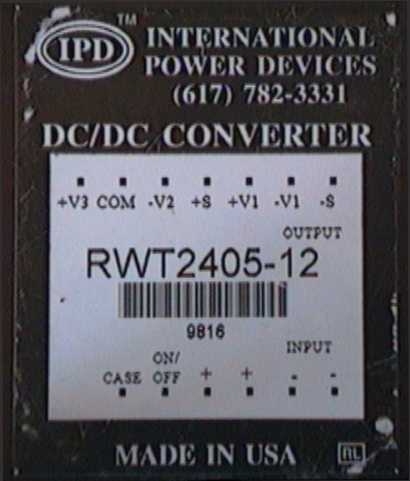
The
additional parts required are:
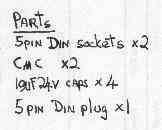
The
circuit diagram of the output filter is:
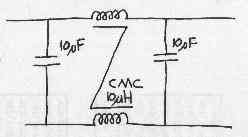
and
the layout of the HiCap sockets is:
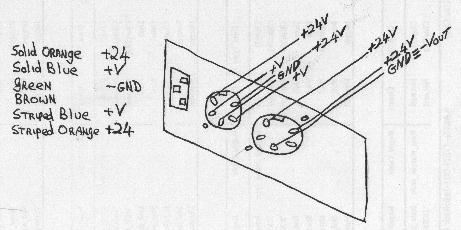
Building
The completed unit is shown below. As it's a prototype, it is
held together with cable ties with milk bottle tops used as
spacers between the two converters.
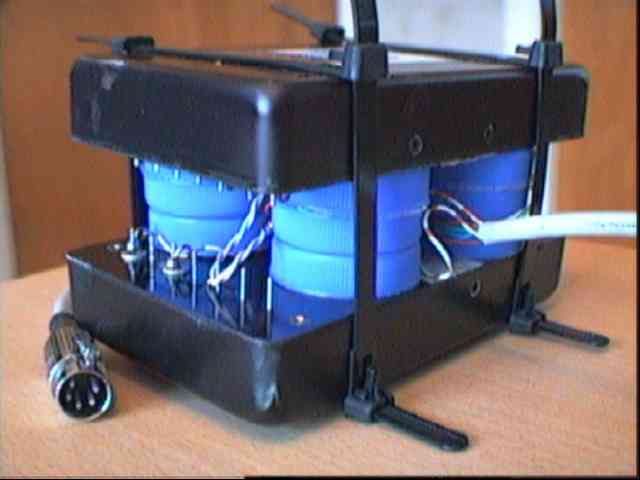
The
next picture shows the unit taken apart and laid flat. The cable
is a salvaged network cable from work. The output filters can be
seen attached to the left hand converter.
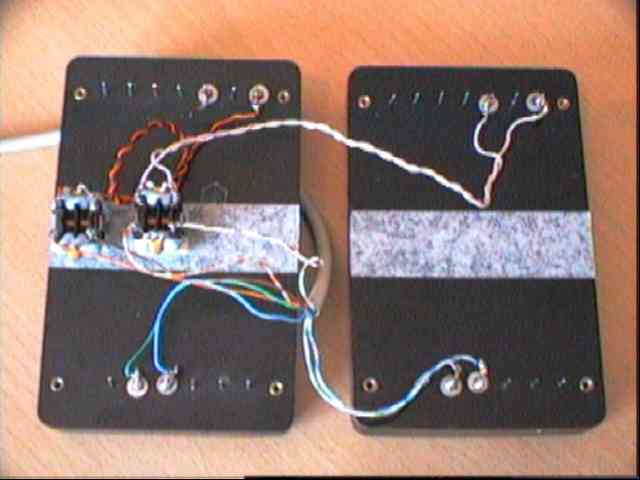
The
next image shows a close up of the output filters. The bodies of
the tantalum capacitors have been attached to the CMCs with Blue
Tack with a bit of credit card in there too.
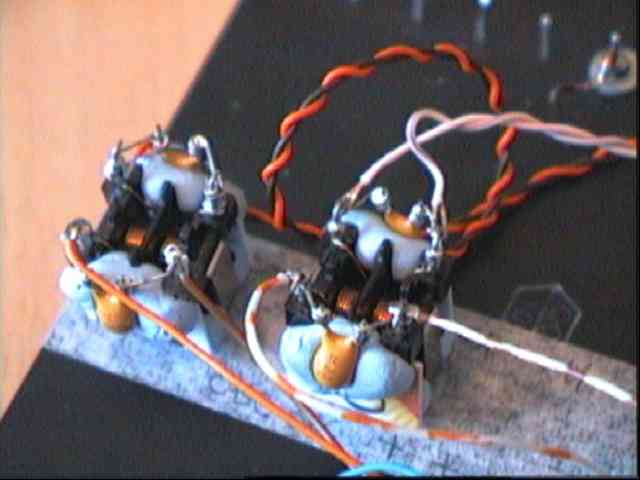
Next
is the HiCap which had two if its 4 pin sockets (which were
unused in my system, if you use yours you will need a different
arrangement) replaced with 5 pin sockets. The sockets that were
replaced were the first and second from the right. The first is
where the DC-DC converter plugs in and the second is a new output
to the Naim pre-amp. The original pre-amp output supplying the
linear regulated 24V remains at the extreme left.
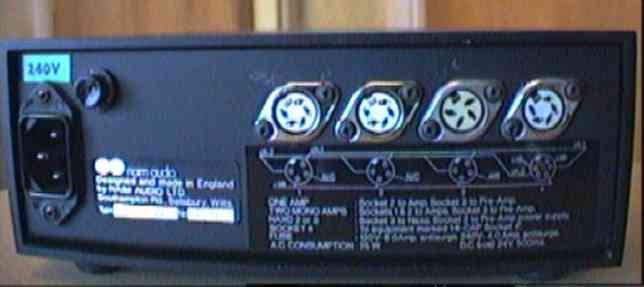
The
image below shows the internal wiring of the HiCap. A feed of
unregulated DC is connected to the new 5 pin DIN socket (black
wiring). The regulated DC produced by the DC-DC converter is
looped internally to the adjacent 5 pin DIN plug in a pin
configuration that matches that of the existing output on the far
left (blue wiring).
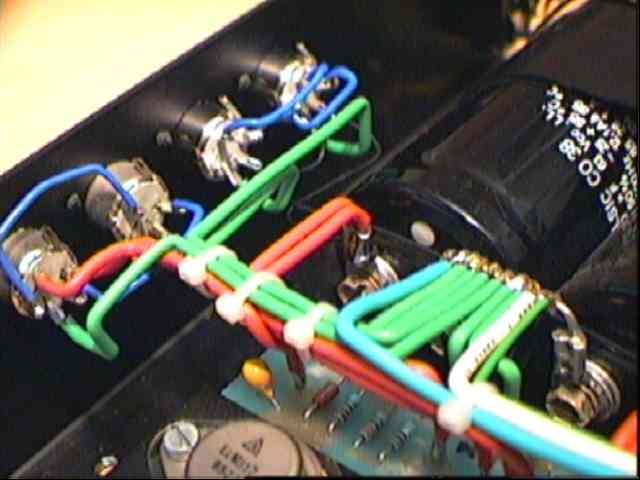
Measurements
I have not put a scope on the PSU but I can say that the
difference in output voltage between left and right channels is
0.1V in contrast with the linear PSU where the channels are 0.5V
apart.
Sound
Let me first say that listening has been limited, only a few
sessions at the time of writing, so only about an hour or two of
listening. However I can say that the two units (the original
linear regulation and the DC-DC regulation) do sound different
and that the converter regulation does not appear to have the
nasties that had been feared.
To put my opinions on the sound differences into perspective
first let me describe the system. A Linn LP12 turntable with
Avondale PSU, subchassis and bearing. A Wilson Benesch ACT-1 arm
and Lyra Clavis DC cartridge. The pre-amp is a tweaked Naim 42.5
and listening was via Audia Technica ATH-7 headphones. For many
years my power amp has been a Quantum 204 transistor amplifier of
1980 vintage but for the last few months it has been a recently
built Electronic Tonalities Paraglow valve amplifier
http://www.bottlehead.com.
I'd describe the difference between the linear PSU and the
converter PSU as similar to the difference between the valve
amplifier and the transistor amp. I have described elsewhere the
change in sound moving from the Quantum to the Paraglow
amplifier, a loss of air, a movement of the image, backwards,
away from the listener and an integration of the individual
sounds. I remember comparing the Quantum with a friends Naim
power amplifier (it was not a 250 model). We both agreed that the
sound from the Naim was more integrated while with the Quantum
the instruments were more individual. My friend who is rather
more forward than I advocated the integrated sound-stage to be
better while both I and my wife when conferring later agreed that
we liked being able to pick out and concentrate on individual
instruments.
When compared with the linear PSU the DC-DC converter PSU
moves away from the sound introduced by the Paraglow amp and back
towards the transistor sound, the sound moves forward and is less
integrated, i.e you are more able to concentrate on individual
instruments. Further opinions will have to wait till I manage to
get someone else to do a comparison or I do further tests,
perhaps with CD and loudspeakers. However in summary, I have to
say I'm quite happy with the DC-DC converter PSU; it moves my
system towards the sound I'm looking for, so for me it
works well though it may not suit every system.
Conclusion
I'm not yet prepared to say, hand on heart, that the DC-DC
converter PSU is better that the linear PSU but I am prepared to
believe it is, and will be looking further proof. I think that as
a proof of concept the project has been a success and I will be
building a PSU for the Pass A75 amplifier using DC-DC converters.
The cost of the project is dictated by the cost of the
converters, which at sale price was £32 + VAT each, however
list price is 3x higher.
Glossary
A - amps, units of current
C - capacitor
choke -
inductor
CMC - common mode choke,
DC - direct current
Hz
- hertz, cycles per second
L - inductor or choke
PSU -
power supply unit
V - volts, units of voltage
© Neil (J Mackie) November
2000.
|